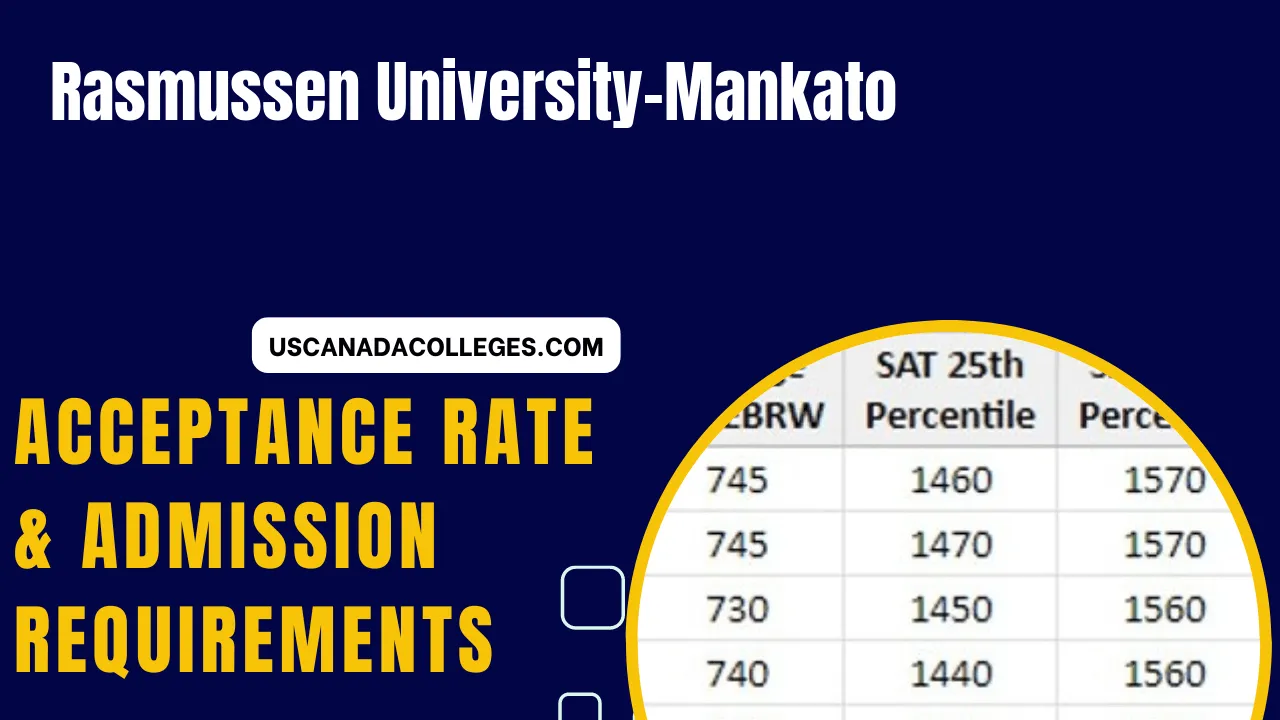The acceptance rate of Rasmussen University-Mankato is not reported. The admission process at Rasmussen University-Mankato is not very strict. Most institutions whose acceptance rate is not reported do not have a high acceptance rate. Hence, we may assume that Rasmussen University-Mankato's admission criteria are not very strict. However, this does not mean that every applicant will be admitted.
To secure admission to Rasmussen University-Mankato, perform well in academics and other activities. Meeting Rasmussen University-Mankato's GPA and standardized test (SAT/ACT) requirements is crucial, as failing to do so may prevent your application from moving forward. Additionally, a well-written letter of recommendation, your participation in co-curricular and extracurricular activities, and your interpersonal communication skills can improve your chances of admission.
Rasmussen University-Mankato Admission Requirements
Can I Get Into Rasmussen University-Mankato Without SAT Or ACT?: The admission test score (SAT/ACT) policy for Rasmussen University-Mankato is unknown. But it is better to submit the test score if you have performed well in the test. It gives an extra opportunity to showcase your skills and competencies and hence will improve your chances of admission. Check the schedule of the test and plan accordingly. It is advisable to appear multiple times in the test unless you score well above the average SAT / ACT score of the admitted students, as given below. Normally, students may appear in the test 4 to 5 times to improve their scores. But if your score is not up to the mark and is less than the national or state average, then it is better not to submit the score as it will impact negatively.
Rasmussen University-Mankato SAT Requirements
Each school has different requirements for SAT and ACT testing. Only a few schools require the SAT or ACT, but many consider your scores if you choose to submit them. The test score policy is already mentioned.
Rasmussen University-Mankato Profile
Name: Rasmussen University-Mankato
City: Mankato
State: Minnesota
Type: Private for Profit
Zip: 56001-5476
Campus: Branch Campus
Accredited by: Higher Learning Commission (NCACHE)
How much a Rasmussen University-Mankato Graduate make?
The average annual salary of the Rasmussen University-Mankato graduate after 4-6 years of graduation is USD 39080. An average Rasmussen University-Mankato graduate makes this much after 10 years of enrollment (4-6 years after graduation).
The average annual income of a graduate in the United States is USD: 40595
Degree Programs
Frequently Asked Questions About Rasmussen University-Mankato Admissions
Answer: Graduates of this university typically earn a lower salary, $39080 annually, especially in non-technical fields.
Question: Is it possible to transfer to Rasmussen University-Mankato from another university?
Answer: Yes, many students successfully transfer to Rasmussen University-Mankato each year. Be prepared with your academic transcripts, recommendation letters, and a solid personal statement to make your application competitive.
Question: What is the campus culture like at Rasmussen University-Mankato?
Answer: The campus culture at Rasmussen University-Mankato is diverse and vibrant, with numerous student organizations, sports teams, and cultural activities. It’s an ideal environment for personal growth and building lifelong connections.
Question: How can I improve my chances of getting into Rasmussen University-Mankato?
Answer: To improve your chances, focus on excelling academically, building a strong extracurricular profile, and submitting standout essays. High SAT/ACT scores are also crucial for competitive admissions.
Full list of All degree programs offered by Rasmussen University-Mankato.
Data on this page is sourced from IPEDS, College Scorecard's latest data as provided in 2024, US Department of Education's latest 2024 statistics, Institute's official websites and printed material as well as additional publicly available sources.
